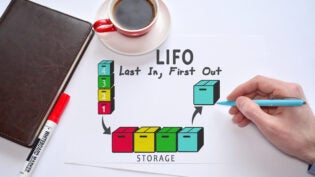How to File Taxes as a Self-Employed Sole Proprietor
By: Wagepoint

The most common form of small business ownership, a sole proprietor (sole proprietorship if you’re being formal) is an “unincorporated business” where the owner literally owns the entire business. As such, for tax reasons, the business and its owner are considered the same tax entity.
Being self-employed literally means working for yourself, which is often the case with sole proprietors. In other words, you’re your own (and only) employee and you’re paying yourself.
To sum up the above: self-employed refers to anyone who chooses to work for themselves and a sole proprietorship is a model of how the business is set up. Now that you have the lingo down, it’s time to conquer tax filing.
What Self-Employed Sole Proprietors Need to Do at Tax Time
As a self-employed sole proprietor, you must claim your business income and expenses on your personal 1040 return by filing a Schedule C, Business Income and Expenses.
Your Form 1040 documents your personal income, while your Schedule C outlines your business income and expenses. Note: If you have multiple businesses that are sole proprietorships, you must file a Schedule C for each business you run.
How do you know if you’re a sole proprietor? If you haven’t filed any paperwork to incorporate, the default for an unincorporated business is a sole proprietorship.
Use Accounting Software
Hopefully, when you established your business, you also invested in reliable small business accounting software, like FreshBooks, LessAccounting, QuickBooks, Wave and Xero. This would also mean that you’ve been following best practices by keeping your books all year long and have records of what you need to file your taxes. If you’ve been using tools to scan receipts and track mileage, even better.
Another perk is most tax preparation software will let you import your income and expenses directly from your accounting software.
If you didn’t invest in accounting software, don’t worry. While this is certainly recommended, the Internal Revenue Service (IRS) does not require it. But, it undoubtedly makes the process of filing your return easier. And if you haven’t been using software, you’ll need to manually gather all your receipts from the year to deduct your business expenses.
Goal: If you have a shoe box of receipts this year, make a point of using the right tools to banish the shoe box next year.
Have a Separate Business Banking Account
Likewise, you should have opened a separate bank account to keep track of your business income separately from your personal income. Not only is this a best practice, should you be audited, the IRS frowns upon the use of a personal account for business income. (And no one likes an angry auditor.)
Find a Good Small Business Accountant
If you’re genuinely nervous about filing business taxes, get help from a Certified Public Accountant (CPA) or a licensed Enrolled Agent. Some questions to ask when choosing a qualified CPA or EA include inquiring as to how long the individual has been licensed, as well as what kind of protection they will afford you in the instance of an IRS audit. As with all sound business decisions, be sure to get the contract for services in writing.
To help you with this decision, check out these articles on choosing an accountant from QuickBooks, Wave and Xero.
Bonus tip: The costs of tax prep software, accounting software or apps are all tax-deductible businesses expenses. That also includes professional accountant fees.
Understand Self-Employment Taxes
When you are a W2 employee working for a business owned by someone else, you and your employer share the burden of paying payroll taxes (employer taxes). On a federal level, this includes paying your Social Security and Medicare Taxes (also known as FICA taxes) — with 50% paid by your employer and 50% paid by you in the form of withholding.
This changes when you start your own business. When you are a business owner, you are 100% responsible for paying your share of your Social Security and Medicare taxes as self-employment taxes — meaning that you pay both your portion and the employer’s portion.
The Social Security tax rate is 12.4%. However, this is applicable only to your first $128,400 of earnings. You will not be subject to Social Security taxes on any amount of profit you earn that is greater than $127,200 for 2017 and $128,400 for 2018.
Medicare taxes work slightly differently. The tax rate for Medicare is 1.45% and does not have an income cap. However, if you earn more than $200,000 as a single filer, $250,000 if married filing jointly or $125,000 if married filing separately, you will be subject to an additional Medicare tax of .9%, making the total amount of tax due 2.35% for your earnings that go over these thresholds.
One small piece of good news. You can deduct up to 50% of your self-employment taxes (the employer portion) from your personal income taxes when calculating your adjusted gross income on your 1040.
Pay Attention to State and Local Taxes Too
In addition to federal income and employment taxes, you are also subject to the tax laws of the state and city where you operate. These taxes include state income tax, sales taxes, transportation and education taxes.
If you’re in a highly regulated industry, you may also be subject to excise or sin taxes. Alcohol, tobacco and gasoline are often subject to excise taxes, as are services, like transporting people or products via planes or local phone service or any lease telephone equipment.
Own a spa that offers tanning? There’s even an excise tax on indoor tanning services.
Note: Sales taxes and excise taxes are not tied to your personal earnings, like income and self-employment taxes. Instead, they are related to the cost of doing business. Any deductions you’d claim for these taxes would be listed on your Schedule C as business tax deductions.
Pay as You Go by Paying Quarterly
Even though your filing deadline isn’t until April, the federal deadline for paying owed business taxes falls on the 15th day of every third month once the fiscal year closes, which places those dates on March 15, June 15, September 15 and December 15 for any business with a fiscal year spanning January 1 to December 31. If any of these dates occur on a weekend or holiday, payment must be made on the next business day.
Along with your business income taxes, your self-employment taxes are typically paid on a quarterly basis through estimated taxes on Form 1040-ES, which is similar to a regular 1040 and provides vouchers to mail in payments (if needed).
If it’s your first year in business, you’ll be asked to estimate both your business and personal income from the business for your business and employment taxes. After that, your taxes are assessed by looking back at the year before.
Many states and local tax authorities also follow quarterly schedules. However, it’s best to verify with each authority.
Find the Best Way to Pay Yourself
When you pay an employee, you pay them wages or a salary. When you pay yourself as the owner of a sole proprietorship, the salary you pay yourself is called a draw (owner’s draw).
In fact, giving yourself a “salary” in the form of a draw helps you establish a regular pattern of income. In turn, it helps you get a clearer idea of the cost of your labor. Finally, if you use small business payroll software, it will help you automate the process of paying yourself.
Payroll software will also help you process your self-employment taxes by withholding and depositing the appropriate amounts and remitting your quarterly payments to the proper tax authorities. (As a business expense, your payroll software subscription fees are also tax deductible from your business income.)
Figuring out exactly how much to pay yourself is a challenge for every business owner. A lot depends on the stage of your business, your individual needs, long-term projections and more. The best bet is to bring your accountant or bookkeeper into this discussion. There are many moving parts and you want to know how each one comes together.
Know the High Cost of Small Business Tax Mistakes and How to Avoid Them
A sizeable tax bill can make a significant impact on your bottom line. As such, it is best to prepare a solid business plan and financial strategy.
The IRS watches small businesses very closely and enforces sanctions the following types of sanctions.
- Failure to File — For not filing a timely tax return.
- Failure to Pay — For failing to meet your tax payment liabilities on time.
- Failure to Deposit — For failing to make required tax deposits for the employer portions of your self-employment taxes.
An important thing to note is the way IRS compounds penalties and interest. For most fines, such as Failure to File or Failure to Pay, the amount goes up by a percentage each month. Failure to Pay penalties increase at the rate of one half of one percent per month — but they can be as high as 1% per month if you as a taxpayer receive a levy notice and do not pay within 10 days. Failure to File penalties increase at a rate of 5% per month and the maximum penalty for both is 25%.
Interest, however, can compound as often as daily. Therefore, it is always in your best interest to pay as much of your outstanding tax liabilities as soon as you can to avoid added interest.
Interest on these penalties continues to compound the longer the issues go unresolved and if there’s willful negligence on your behalf, there can also be civil and criminal charges.
Learn How to Lower Your Tax Liabilities
Now that you understand your tax obligations as a sole proprietor, you probably could use some tips on minimizing your tax liability. The best way to reduce your tax bill is by maximizing any small business tax deductions for which you qualify, such as:
- Mileage: For business travel, you will want to invest in a mileage log. While you may choose to take either the standard mileage deduction or actual costs, be advised that once you use the actual cost method, you must keep using that method for subsequent years. In most cases, it’s best to stick to the standard mileage for the most significant deduction across several years.
- Home Office: To claim the home office deduction, the separate room or structure you claim must be used solely for business. For your home office, you can deduct a percentage of your household expenses attributable to your home office use. There are two ways to claim this deduction: through the simplified method of multiplying your office’s square footage by $5 or using Form 8829 to calculate itemized expenses over $1500.
- Other Expenses: For all other deductions, such as self-employed medical insurance costs, office supplies, phone and internet fees and other miscellaneous expenses, you will want to keep careful records. While the IRS will allow the use of bank statements, you should be able to prove expenses that can be easily confused with personal costs — such as trips to Walmart or shopping on Amazon — were indeed for business use. Like having a separate business banking account, a dedicated business credit card is also a good idea.
When filing taxes for the 2018 fiscal year, sole proprietors may be able to take advantage of a new 20% pass-through deduction on their business income. The deduction is tiered by income and personal filing status (married filing jointly, single, etc.) and industry classification. As this is a new deduction with new rules, many professional organizations are asking for further clarification on the details. In other words, you’ll definitely want to read up on this one and get help from a tax professional before claiming this deduction.
Take a Deep Breath
You always knew being an entrepreneur wasn’t for the faint of heart. Like anything else, if you plan and prepare, sole proprietorship taxes don’t have to be the monster at the end of your year.
The advice we share on our blog is intended to be informational. It does not replace the expertise of accredited business professionals.
 Author: Marketing specialist and the founder of the career and lifestyle advice blog Punched Clocks (www.punchedclocks.com), Sarah Landrum is a business and career expert with a passion for writing. Between posts, Sarah spends her time chasing her dogs through the yard and DIYing her home.
Author: Marketing specialist and the founder of the career and lifestyle advice blog Punched Clocks (www.punchedclocks.com), Sarah Landrum is a business and career expert with a passion for writing. Between posts, Sarah spends her time chasing her dogs through the yard and DIYing her home.














